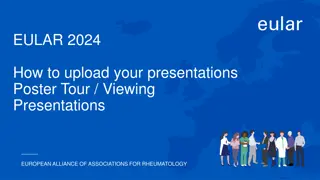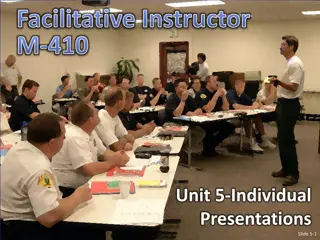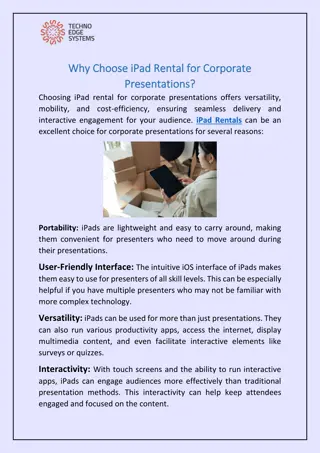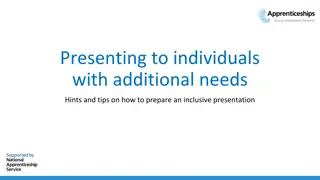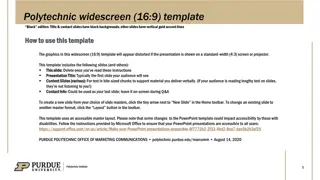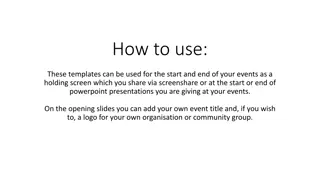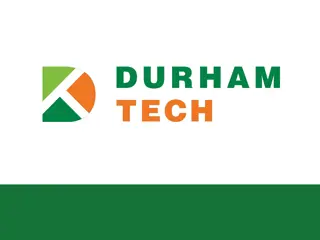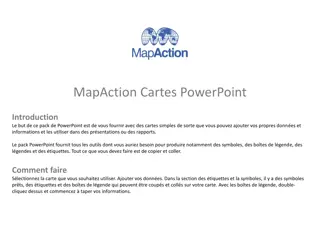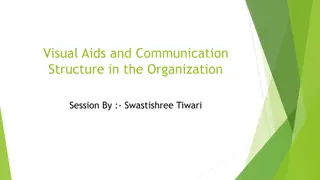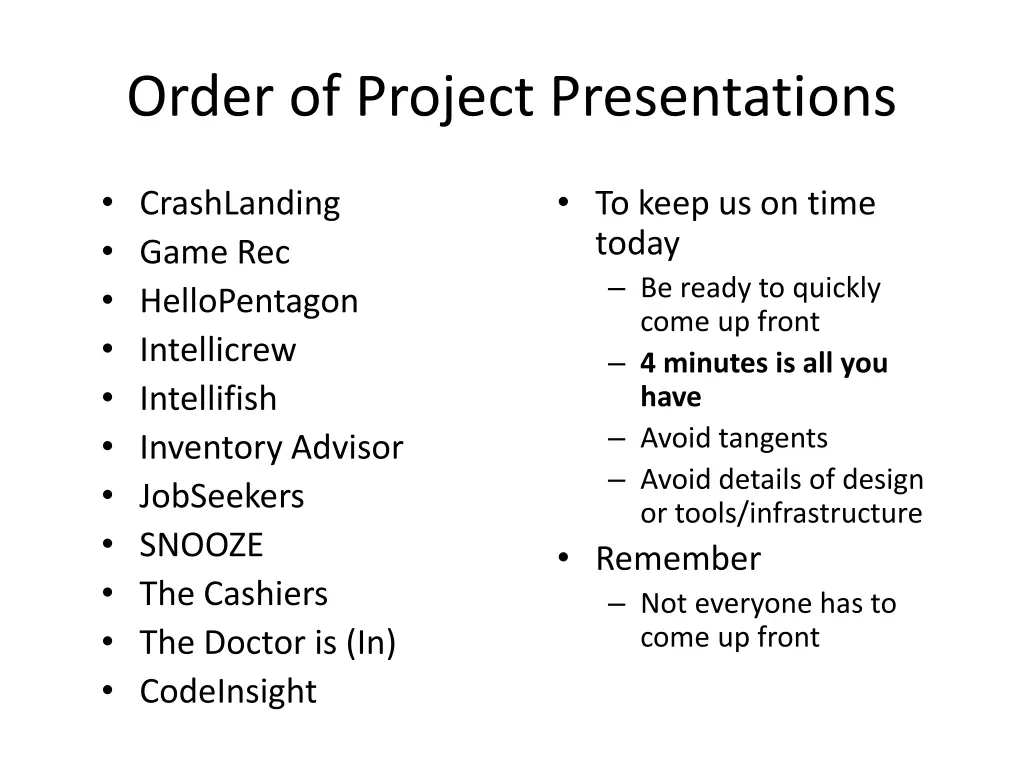
Innovative Strategies for Interviewer Assistance in Qualitative Interviews
Enhance interviewer efficiency with personalized real-time assistance in qualitative interviews. Address cognitive and social issues, provide memory-based aid, and track successful questioning patterns to deepen engagement.
Download Presentation

Please find below an Image/Link to download the presentation.
The content on the website is provided AS IS for your information and personal use only. It may not be sold, licensed, or shared on other websites without obtaining consent from the author. If you encounter any issues during the download, it is possible that the publisher has removed the file from their server.
You are allowed to download the files provided on this website for personal or commercial use, subject to the condition that they are used lawfully. All files are the property of their respective owners.
The content on the website is provided AS IS for your information and personal use only. It may not be sold, licensed, or shared on other websites without obtaining consent from the author.
E N D
Presentation Transcript
Order of Project Presentations CrashLanding Game Rec HelloPentagon Intellicrew Intellifish Inventory Advisor JobSeekers SNOOZE The Cashiers The Doctor is (In) CodeInsight To keep us on time today Be ready to quickly come up front 4 minutes is all you have Avoid tangents Avoid details of design or tools/infrastructure Remember Not everyone has to come up front
CrashLanding: Intelligent assistant to facilitate information elicitation in qualitative interview Jiwon Chun, Shuning Gu, Junru Liu, Yi Wen, Hangxiao Zhu
The Big Idea Personalized real-time assistance to help interviewer dig deeper Goals Sub-goal 1: Understand the ongoing conversation and identify relevant topic on the prepared interview script Sub-goal 2: Minimize the interaction required for marking important information during the interview Sub-goal 3: Provide memory-based assistance to remind the interviewer what has been said and suggest what to follow-up
Issues Issues Cognitive Issues Distraction: How to enable effortless user input to avoid being distracted from the main activity when doing interview? Social Issues Over-reliance on the System: Interviewers might rely too much on the system s suggestions without listening carefully enough, this could affect the quality of the interview. Imbalance of Power Dynamics: If interviewees are aware that an AI system is determining or suggesting the upcoming questions, they might feel uncomfortable and feel that they are talking to AI Other Issues Handling Ambiguous or Incomplete Responses: If the responses from the interviewees are not clear enough to be analyzed by the system, it might fail to generate next appropriate questions. Synchronizing Follow-Up Questions with Interviewer Intent: The system generated questions might not align with the interviewer s intended direction.
Where is the Intelligence? Allow interviewers to choose between different question styles (open-ended vs. specific) based on interviewee responses or user preferences. Track past interactions to identify successful questioning patterns, adjusting suggestions to encourage deeper engagement in future interviews Implement non-intrusive, context-aware prompts that only appear when the interviewer needs assistance, helping maintain focus without overwhelming the user.
Work plan jiwon Chun UX/UI Design Yi Wen System Development Hangxiao Zhu System Development Shuning Gu Technical Optimization Junru Liu Evaluation Design Based on the actual work situation, there may be overlap in everyone's tasks Next up: Game Rec
Game Rec: Video Game Recommendations Akash Jothi, Annie Ren, Erik Day, Esben Egholm, Spencer Cho, Kyne Sun
The Big Idea Recommendation system for video games Goals Congregate user sentiment on specific video games Provide standardized rating interfaces for games Inform users on what games are worth playing based on their preferences Discover gaps in current review systems
Issues Issues Cognitive Issues Users sometimes have trouble assigning a numerical value for a rating. Social Issues Certain users may simply be negative, and rate most games poorly, or even the opposite sort of user. Other Issues Integrating the multiple aspects of the project together smoothly. User s preference for games might shift for a number a factors such as changes in time commitment, emotional state, and boredom of one genre
Where is the Intelligence? Integration of artificial intelligence to allow for suggestions based off of user input Idea: A user describes their interests, previous games they have either liked or disliked through a chat box, and through the use of AI, games are suggested based on these preferences
Work plan - Akash Jothi - Front End, database integration - Spencer Cho - Front End, general UI - Annie Ren - Front End, recommendation system - Esben Egholm - Back End, database integration - Kyne Sun - Back End, UI functionality - Erik Day - Back End, recommendation system Next up: HelloPentagon
HelloPentagon Arunesh Mishra Steve Wang Johnny Le Yoojun Kim Soumyajyoti Dutta
Overview High-level Design Idea Content-aware interactive user interface for malware detection Goals Train a reliable machine learning model for the desired classification task Evaluate the model performance w.r.t standard benchmark Design and implement an interactive & User-friendly UI Implementation of features (hashing, signature patterns, family- clusters, VirusTotal integration, dashboard, severity rating, drift detection) Documentation
Issues Technical Issues Accuracy of detecting malware. Malware can possibly escape while it is analyzed online if not careful. The front-end and back-end for this project has a lot of intricacies. How to represent tasks with multiple sequences of steps and combine them? Cognitive Issues Users may have a difficulty understanding complex malware reports. A compilation of user behaviors i.e., suggestive and interactive with same UI? Social Issues User Diversity - expert cybersecurity users may want a more elaborate malware report, while general users may not be able to understand such information. With a more advanced UI, the application takes away jobs from cyber security analysts. Other Issues Catching dangerous files is always tricky as malware evolves: Concept Drift.
Solution Primary Features We ll give access to our standard data and model to detect the malware The model is open-source so user can update the model by introducing additional data We ll provide information about the malware family and ssdeep hash for a given file User can decide whether to flag a file or not based on severity rating Intelligent Features Provide information about drift and malware evolution Benchmark test using VirusTotal - providing user an option to go beyond Dashboard and statistics of user s database Provide evolution information for better understanding of the sample Adaptive Behaviour based on user needs
Work plan Arunesh Dataset Accessibility, Preprocessing and Intelligent Features Dev Soumya Backend ML Pipeline Ideation and partial implementation of additional intelligent features Steve Frontend UI, integration with backend Yoojun Frontend UI, integration with backend Johnny Develop UI Mockups Look at adaptive options for application Next up: IntelliCrew
IntelliCrew: Adaptive Task Manager for ADHD Users Ayesha Ahmed Nihar Chauhan Shubham Chorage Prakhar Singh Kexuan Shen
The Big Idea High-level Design Idea: Adaptive Task Manager for ADHD Users: A system that provides personalized task breakdowns and reminders based on user preferences, focus levels, and past performance helping ADHD users manage tasks more effectively. Goals Users enter tasks and system uses Natural Language Processing (NLP) to identify actions and then divide them into smaller and manageable steps. Send reminders at flexible intervals based on user behavior. E.g., Users who frequently lose focus get more frequent reminders while focused users get fewer reminders. Provides a visual dashboard that tracks the user's task completion status e.g., progress bars, checklists. The system learns from the user s behaviour of task completion and adjusts focus mode and task suggestions based on past performance. Allow users to share tasks and track team progress and also ensures that ADHD users don t feel overwhelmed by team collaboration tasks.
Issues Issues Cognitive Issues How to deal with distractions? Implement a focus mode where only essential information is displayed Social Issues What if there are several users attempted to collaborate? Use clear visualization for shared tasks, and use visual cues with limited clutter to display contributions without overwhelming users Other Issues What if a user has a large amount of visible tasks available at once? Limit the number of visible tasks and allow users to focus on a single task at a time
Where is the Intelligence? The app can be used by ADHD users to enhance the standard interface. This will include a adaptive task flow with an adjustable task size based on user performance. It is aimed to track task completion and time. This will offer personalized recommendations (shorter steps, focus mode, tailoring reminders). Alternative procedures: Users can choose if they want fewer or larger steps with step by step instructions based on their choices. Adapt based on success: If users complete tasks quickly, larger steps are shown. If opposite is the case, the app breaks tasks into smaller steps.
Work plan Ayesha Ahmed & Shubham Chorage Frontend Development Prakhar Singh Backend Development Kexuan Shen Data Analysis and Insights Generation Nihar Chauhan UI Design Next up: IntelliFish
IntelliFish: Your Topic Yafei Li Yichen Tao Zhenrui Wang Hanyun Yin Linhao Zhou
The Big Idea High-level Design Idea: Personalized and position-oriented Resum /CV builder Goals Capture user knowledge and preferences Filter web-based information centered by user task Provide integrated end-to-end solution
Issues Cognitive Issues Overwhelming cognitive efforts required to identify and highlight relevant skills and experiences Social Issues Universal problem of insufficient preparation on application materials due to high opportunity cost Other Issues Technical gap for general C-end user lead to compromised presentation of applicant qualifications
Where is the Intelligence? User preference based top-k design element recommendation and content contextualization Dynamic user task (targeted position) oriented content adaptation Intelligent user task oriented recommendation on mock interviewing questions
Work plan Yichen Tao - Backend coding and Report writeup Yafei Li - Frontend coding and Questionnaire design Lianhao Zhou Modules Design and Backend Coding Hanyun Yin - System Design and Backend Coding Zhenrui Wang - Frontend coding and Document writeup Next up: Intelligent Advisor
Intelligent Advisor Nazar Oladepo, Bidwat Pokhrel, and Esau Hutcherson
Overview: High-level Design Idea: Given a user s hardware specifications, applications they are using or they plan on using, and their budget, give the user recommendations on hardware upgrades and software optimization. Goals Detect the user s machine specifications and software they are currently utilizing. Collect data on software that the user wants to run on their machine. Suggest required hardware upgrades on the user s machine. Provide steps to optimize their current system by proposing software optimization tasks.
Issues Issues Cognitive Issues User does not want to spend money User does not understand how to upgrade their hardware or utilize their software User inputs incorrect performance information Social Issues Our recommendation could favor certain hardware or systems based on popularity and not overall performance indicators. Technology/Design Issues Data available may be incorrect or unable to be found. System might not have access to automatically perform suggested actions on the software level.
Where is the Intelligence? Ways in which you plan to go beyond the standard interface for this task Given multiple applications to optimize for given a certain budget give the best recommendation that optimizes for all applications. Alongside this give instructions for the user for software usage optimization.
Work plan Esau Hutcherson Data collection/Data Handling/ implements LLM for recommendation generation Nazar Oladepo UI/UX design Bidwat Pokhrel Collect System Information / Connect UI with Data/LLM Next up: JobSeeker
JobSeeker: Easy Job Hunting Amalesh Arivanan, Emory Lu, Mahirah Samah
The Big Idea Personalized Job Recommendations based on User preferences Goals Capture user input through conversational prompts Represent Job Requirements & Matching Criteria Generate Personalized Job Recommendations Future Enhancements: Interactive Dashboards Autofill Tool Job Boards Integration AI-Powered Resume Reviews
Issues Cognitive Issues Information Overload How to avoid irreverent job recommendations (e.g. Linkedin does this all the time.) Social Issues How to protect users privacy? Most automated job recommendations are impersonal. How to evaluate Work-Life-Balance for each job? Technology/Design Issues How to ensure all recommendations are up-to-date? How to keep a balance between a user-friendly design and information clarity?
Where is the Intelligence? AI Chatbot AI job recommendation Example: User will receive initial job recommendations, then talk to Chatbot about preferences Chabot will update the job recommendations based on user feedback Conversational Chatbot interface
Work plan Amalesh Arivanan (Team Leader) Create and manage the overall implementation plan Assign tasks to team members Emory Lu Implement assigned tasks Organize project documentation & schedule team meetings Mahirah Samah Implement assigned tasks Communicate with the professor (e.g. send out emails) Next up: SNOOZE
SNOOZE Smart Notification and Optimised Organization with Zero Effort Kathan Vyas, Prachi Surbhi, Ashwin Raja, Shreyas Kasetty, Austin McCormick
The Big Idea High-level Design Idea Developing an interface that talks with email and message APIs and understands the social profiles around a user to provide an intelligent summary as well as a dependable organizer to pair with the productivity applications. Goals Enhance Productivity: Streamline email and task management to significantly reduce time spent on non-essential activities. Seamless Integration: Achieve smooth and reliable connectivity with diverse communication platforms to ensure consistent data handling. Accurate Content Management: Utilize sophisticated classification and prioritization techniques to manage emails effectively based on their relevance and urgency. Adaptive Learning: Continuously learn from user interactions to enhance personalization and effectiveness of the assistant over time.
Issues Issues Cognitive Issues Implement strategies to minimize distractions during email review and task execution. Social Issues Developing a model that understands social profiles, creates a mental note of priority of those profiles. Other Issues Design a flexible system architecture that can dynamically adjust to complex, multi-step tasks. Ensure seamless transitions in task handling and presentation adjustments in response to real-time changes in user personalization preferences.
Where is the Intelligence? Social Profile Prioritization: SNOOZE learns to recognize and prioritize emails based on the social importance of the sender, crafting summaries that reflect these priorities to optimize user attention. Integrated Task Management: The assistant proactively handles organizing and scheduling by interacting with other applications, reducing the need for manual intervention across different platforms. Adaptive Scheduling Intelligence: SNOOZE adapts to user preferences and past scheduling successes, automating and refining future calendar events and responses without user input.
Work plan Kathan Develop the system that understands social profile priority Prachi User interface design Ashwin Frontend development Shreyas Integration with email endpoint Austin Natural Language Processing Next up: The Cashiers
The Cashiers: Shoptimum Marshall McIlyar Akshath Venkataraman Hector Cardenas Benson Nguyen
The Big Idea Maximize nutrition and food quality, and minimize cost and user effort Goals Understand user preferences over time Gather information from grocery stores near user Generate a weekly shopping list Generate a weekly recipe list/meal plan Optionally: regularly schedule grocery deliveries
Issues Issues Cognitive Issues One off searches and purchases could affect grocery list builder Users have limited information of available groceries at the store How do we communicate the recipes to the user properly? Social Issues Same products get recommended to everyone, then runs out of stock Stores could price gouge based on past recommendations Family members might want their own accounts Other Issues How would we track grocery stock? How would we track grocery prices?
Where is the Intelligence? Users input information, such as searches and purchases, which our program listens to, and uses to develop the grocery lists Users can also modify lists given to them, which is used as feedback for future grocery lists Program uses real time grocery store information to make decisions
Work plan Overall things that still need to be finalized What software stack/frameworks will we be using? What variables will we factor in? (calories, macros, vegetable count, cost, cooking time, etc.) Marshall McIlyar Frontend & Mock Scenario Setup Akshath Venkataraman Frontend & Data Processing Hector Cardenas UI Design & Testing Benson Nguyen Backend (Shopping List/Recipe Algorithm) Next up: The Doctor is (In)
The Doctor Is [In]: Interactive Rare Disease Database Qizhuo Shen, Sicheng Chen, Annan Zou
The Big Idea System to rule out / recommend for consideration rare diseases for healthcare personnel making diagnosis and treatment a specialized Clinical Decision Support System (CDSS) Goals Encoded knowledge base of rare diseases that users can access Specify user identity/specialization/expertise Capable of providing diagnosis and treatment recommendations to users based on user s healthcare role, patient symptoms and lab/examination results (text based), and patient health history Users able to provide feedback to individual recommendations
Issues Cognitive Issues Unaware of the existence / possibility of certain diseases Especially for endemic diseases in marginalized demographics Confirmation bias leading to overseeing signs Expectations will align to the most common diseases Symptoms can be extremely generic and hard to distinguish DSS can only help to a certain extent but can recommend more accurate lab options & integrate these results
Issues (contd) Social Issues Incomplete patient profiles Unawareness, forget, or reluctance Least effort diagnosis / treatment It s always allergy Other Issues Accountability issue associated with pure deep learning based CDSS Could not trace and explain individual decisions Alert Desensitization If CDSS randomly recommends unlikely rare diseases all the time, might choose not to engage with recommendations at all


